Double Feedback Control Method for Determining Early-Age Restrained Creep of Concrete Using a Temperature Stress Testing Machine
Abstract
1. Introduction
2. Materials and Methods
2.1. Double Feedback Control Method and Creep Calculation Method Using the TSTM
2.2. Singles Feedback Control Method and Creep Calculation Method Using the TSTM
2.3. Materials
2.4. Experimental Procedure
3. Results and Discussion
3.1. Restrained Stress
3.2. Free and Restrained Deformation
3.3. Restrained Creep
4. Conclusions
- (1)
- The TSTM is a very useful instrument for determining the early-age restrained creep of dam concrete under the combined effects of varying temperature, creep recovery, tension and compression stress, and early age. The double feedback control method for a TSTM can hold the stress constant during the compensation cycle, eliminating the restrained elastic deformation.
- (2)
- The restrained creep measured by the conventional single feedback TSTM control method neglects the effects of restrained elastic deformation, and as a result, the measured creep is larger than the actual value. A new creep calculation equation for single feedback method was, accordingly, derived. The results calculated with the proposed equation show positive agreement with the results of the more accurate double feedback method.
- (3)
- The difference in restrained creep between single and double feedback methods is significant in low elastic modulus concrete and can be neglected in high elastic modulus concrete.
Author Contributions
Funding
Acknowledgments
Conflicts of Interest
References
- Bofang, Z. Thermal Stresses and Temperature Control of Mass Concrete, 1st ed.; Butterworth-Heinemann: Waltham, MA, USA, 2013; pp. 1–10. ISBN 978-0-12-407723-2. [Google Scholar]
- Tao, Z.; Weizu, Q. Tensile creep due to restraining stresses in high-strength concrete at early ages. Cem. Concr. Res. 2006, 36, 584–591. [Google Scholar] [CrossRef]
- Altoubat, S.A.; Lange, D.A. Creep, shrinkage, and cracking of restrained concrete at early age. ACI Mater. J. 2001, 98, 323–331. [Google Scholar]
- Shen, D.; Jiang, J.; Wang, W.; Shen, J.; Jiang, G. Tensile creep and cracking resistance of concrete with different water-to-cement ratios at early age. Constr. Build. Mater. 2017, 146, 410–418. [Google Scholar] [CrossRef]
- Li, K.; Ju, Y.; Han, J.; Zhou, C. Early-age stress analysis of a concrete diaphragm wall through tensile creep modeling. Mater. Struct. 2009, 42, 923–935. [Google Scholar] [CrossRef]
- Li, Q.; Liang, G.; Hu, Y.; Zuo, Z. Numerical analysis on temperature rise of a concrete arch dam after sealing based on measured data. Math. Probl. Eng. 2014, 2014, 602818. [Google Scholar] [CrossRef]
- Atrushi, D.S. Tensile and Compressive Creep of Early Age Concrete: Testing and Modelling. Ph.D. Thesis, The Norwegian University of Science and Technology, Trondheim, Norway, 2003. [Google Scholar]
- Altoubat, S.A.; Lange, D.A. Tensile basic creep: Measurements and behavior at early age. ACI Mater. J. 2001, 98, 386–393. [Google Scholar]
- Pane, I.; Hansen, W. Investigation on key properties controlling early-age stress development of blended cement concrete. Cem. Concr. Res. 2008, 38, 1325–1335. [Google Scholar] [CrossRef]
- Hauggaard, A.B.; Damkilde, L.; Hansen, P.F. Transitional thermal creep of early age concrete. J. Eng. Mech. 1999, 125, 458–465. [Google Scholar] [CrossRef]
- Sabeur, H.; Meftah, F. Dehydration creep of concrete at high temperatures. Mater. Struct. 2008, 41, 17–30. [Google Scholar] [CrossRef]
- Bazant, Z.P.; Baweja, S. Creep and shrinkage prediction model for analysis and design of concrete structures: Model B3. ACI Spec. Publ. 2000, 194, 1–84. [Google Scholar]
- Bazant, Z.P.; Cusatis, G.; Cedolin, L. Temperature effect on concrete creep modeled by microprestress-solidification theory. J. Eng. Mech. 2004, 130, 691–699. [Google Scholar] [CrossRef]
- Ladaoui, W.; Vidal, T.; Sellier, A.; Bourbon, X. Effect of a temperature change from 20 to 50 °C on the basic creep of HPC and HPFRC. Mater. Struct. 2011, 44, 1629–1639. [Google Scholar] [CrossRef]
- Vidal, T.; Sellier, A.; Ladaoui, W.; Bourbon, X. Effect of temperature on the basic creep of high-performance concretes heated between 20 and 80 °C. J. Mater. Civ. Eng. 2014, 27, B4014002. [Google Scholar] [CrossRef]
- Schutter, G.D.; Yuan, Y.; Liu, X.; Jiang, W. Degree of hydration-based creep modeling of concrete with blended binders: From concept to real applications. J. Sustain. Cem. Based Mater. 2015, 4, 1–14. [Google Scholar] [CrossRef]
- Jiang, W.; Schutter, G.D.; Yuan, Y. Degree of hydration based prediction of early age basic creep and creep recovery of blended concrete. Cem. Concr. Compos. 2014, 48, 83–90. [Google Scholar] [CrossRef]
- Briffaut, M.; Benboudjema, F.; Torrenti, J.; Nahas, G. Concrete early age basic creep: Experiments and test of rheological modelling approaches. Constr. Build. Mater. 2012, 36 (Suppl. C), 373–380. [Google Scholar] [CrossRef]
- Hermerschmidt, W.; Budelmann, H. Creep of early age concrete under variable stress. In Proceedings of the 10th International Conference on Mechanics and Physics of Creep, Shrinkage, and Durability of Concrete and Concrete Structures, Vienna, Austria, 21–23 September 2015; American Society of Civil Engineers (ASCE): Vienna, Austria, 2015; pp. 929–937. [Google Scholar] [CrossRef]
- Delsaute, B.; Boulay, C.; Staquet, S. Creep testing of concrete since setting time by means of permanent and repeated minute-long loadings. Cem. Concr. Compos. 2016, 73, 75–88. [Google Scholar] [CrossRef]
- Delsaute, B.; Torrenti, J.; Staquet, S. Modeling basic creep of concrete since setting time. Cem. Concr. Compos. 2017, 83, 239–250. [Google Scholar] [CrossRef]
- Østergaard, L.; Lange, D.A.; Altoubat, S.A.; Stang, H. Tensile basic creep of early-age concrete under constant load. Cem. Concr. Res. 2001, 31, 1895–1899. [Google Scholar] [CrossRef]
- Wei, Y.; Guo, W.; Liang, S. Microprestress-solidification theory-based tensile creep modeling of early-age concrete: Considering temperature and relative humidity effects. Constr. Build. Mater. 2016, 127, 618–626. [Google Scholar] [CrossRef]
- Springenschmid, R.; Breitenbiicher, R. Are low heat cements the most favourable cements for the prevention of cracks due to heat of hydration? Concr. Precast. Plant Technol. 1986, 52, 704–711. [Google Scholar]
- Kovler, K. Testing system for determining the mechanical behaviour of early age concrete under restrained and free uniaxial shrinkage. Mater. Struct. 1994, 27, 324–330. [Google Scholar] [CrossRef]
- Klausen, A.E.; Kanstad, T.; Bjøntegaard, Ø.; Kollegger, J.; Hellmich, C.; Pichler, B. Updated Temperature-Stress Testing Machine (TSTM): Introductory Tests, Calculations, Verification, and Investigation of Variable Fly Ash Content. In Proceedings of the 10th International Conference on Mechanics and Physics of Creep, Shrinkage, and Durability of Concrete and Concrete Structures, Vienna, Austria, 21–23 September 2015; American Society of Civil Engineers (ASCE): Vienna, Austria, 2015; pp. 724–732. [Google Scholar] [CrossRef]
- Staquet, S.; Delsaute, B.; Darquennes, A.; Espion, B. Design of a revisited TSTM system for testing concrete since setting time under free and restraint conditions. In Proceedings of the Concrack3—RILEM-JCI International Workshop on Crack Control of Mass Concrete and Related Issues Concerning Early-Age of Concrete Structures, Paris, France, 15–16 March 2012; Concrack3—RILEM-JCI: Paris, France, 2012; pp. 99–110. [Google Scholar]
- Charron, J.P.; Bissonnette, B.; Marchand, J.; Pigeon, M. Test device for studying the early-age stresses and strains in concrete. ACI Spec. Publ. 2004, 220, 113–124. [Google Scholar] [CrossRef]
- Zhu, H.; Li, Q.; Hu, Y. Self-developed testing system for determining the temperature behavior of concrete. Materials 2017, 10, 419. [Google Scholar] [CrossRef] [PubMed]
- Wei, Y.; Liang, S.; Guo, W. Decoupling of autogenous shrinkage and tensile creep strain in high strength concrete at early ages. Exp. Mech. 2017, 57, 475–485. [Google Scholar] [CrossRef]
- Klausen, A.E.; Kanstad, T.; Bjøntegaard, Ø.; Sellevold, E. Comparison of tensile and compressive creep of fly ash concretes in the hardening phase. Cem. Concr. Res. 2017, 95, 188–194. [Google Scholar] [CrossRef]
- Wei, Y.; Hansen, W. Tensile creep behavior of concrete subject to constant restraint at very early ages. J. Mater. Civ. Eng. 2013, 25, 1277–1284. [Google Scholar] [CrossRef]
- Bjøntegaard, Ø.; Sellevold, E.J. The temperature-stress testing machine (TSTM): Capabilities and limitations. In Proceedings of the First International RILEM Symposium on Advances in Concrete Through Science and Engineering, Evanston, IL, USA, 21–24 March 2004; Weiss, J., Kovler, K., Marchand, J., Eds.; RILEM Publications SARL: Evanston, IL, USA, 2004. [Google Scholar]
- Cusson, D.; Hoogeveen, T. An experimental approach for the analysis of early-age behaviour of high-performance concrete structures under restrained shrinkage. Cem. Concr. Res 2007, 37, 200–209. [Google Scholar] [CrossRef]
- Pigeon, M.; Toma, G.; Delagrave, A.; Bissonnette, B.; Marchand, J.; Prince, J.C. Equipment for the analysis of the behaviour of concrete under restrained shrinkage at early ages. Mag. Concr. Res. 2000, 52, 297–302. [Google Scholar] [CrossRef]
- Kanstad, T.; Hammer, T.A.; Bjøntegaard, Ø.; Sellevold, E.J. Mechanical properties of young concrete: Part II: Determination of model parameters and test program proposals. Mater. Struct. 2003, 36, 226–230. [Google Scholar]
- The Ministry of Water Resources of the People’s Republic of China. Test Code for Hydraulic Concrete; SL 352-2006; China Water Power Press: Beijing, China, 2006.
- Delsaute, B.; Boulay, C.; Granja, J.; Carette, J.; Azenha, M.; Dumoulin, C.; Karaiskos, G.; Deraemaeker, A.; Staquet, S. Testing concrete E—Modulus at very early ages through several techniques: An inter—Laboratory comparison. Strain 2016, 52, 91–109. [Google Scholar] [CrossRef]
- Zhu, H.; Hu, Y.; Li, Q.; Zhang, M. Determination of concrete elastic modulus in early age for temperature stress testing under the effect of restraint. In Proceedings of the 2nd International RILEM/COST Conference on Early Age Cracking and Serviceability in Cement-Based Materials and Structures—EAC2, Brussels, Belgium, 12–14 September 2017; ULB and VUB: Brussels, Belgium, 2017. [Google Scholar]
- Mehta, P.K.; Monteiro, P.J.M. Concrete: Microstructure, Properties, and Materials, 4th ed.; McGraw-Hill Publishing: New York, NY, USA, 2006; pp. 64–70. ISBN 1281080799. [Google Scholar]
- Kovler, K.; Igarashi, S.; Bentur, A. Tensile creep behavior of high strength concretes at early ages. Mater. Struct. 1999, 32, 383–387. [Google Scholar]
- Shen, D.J.; Jiang, J.L.; Shen, J.X.; Yao, P.P.; Jiang, G.Q. Influence of prewetted lightweight aggregates on the behavior and cracking potential of internally cured concrete at an early age. Constr. Build. Mater. 2015, 99, 260–271. [Google Scholar] [CrossRef]
- Christensen, R. Theory of Viscoelasticity: An Introduction; Elsevier: Dordrecht, The Netherlands, 2012; ISBN 0323161820. [Google Scholar]
- Gilbert, R.I. Time Effects in Concrete Structures; Elsevier: New York, NY, USA, 1988; Volume 23, ISBN 0167-6288. [Google Scholar]
- Neville, A.M.; Dilger, W.H.; Brooks, J.J. Creep of Plain and Structural Concrete; Construction Press: London, UK, 1983; ISBN 9780860958345. [Google Scholar]
- Pane, I.; Hansen, W. Predictions and verifications of early-age stress development in hydrating blended cement concrete. Cem. Concr. Res. 2008, 38, 1315–1324. [Google Scholar] [CrossRef]
- Wei, Y.; Liang, S.; Guo, W.; Hansen, W. Stress prediction in very early-age concrete subject to restraint under varying temperature histories. Cem. Concr. Compos. 2017, 83, 45–56. [Google Scholar] [CrossRef]

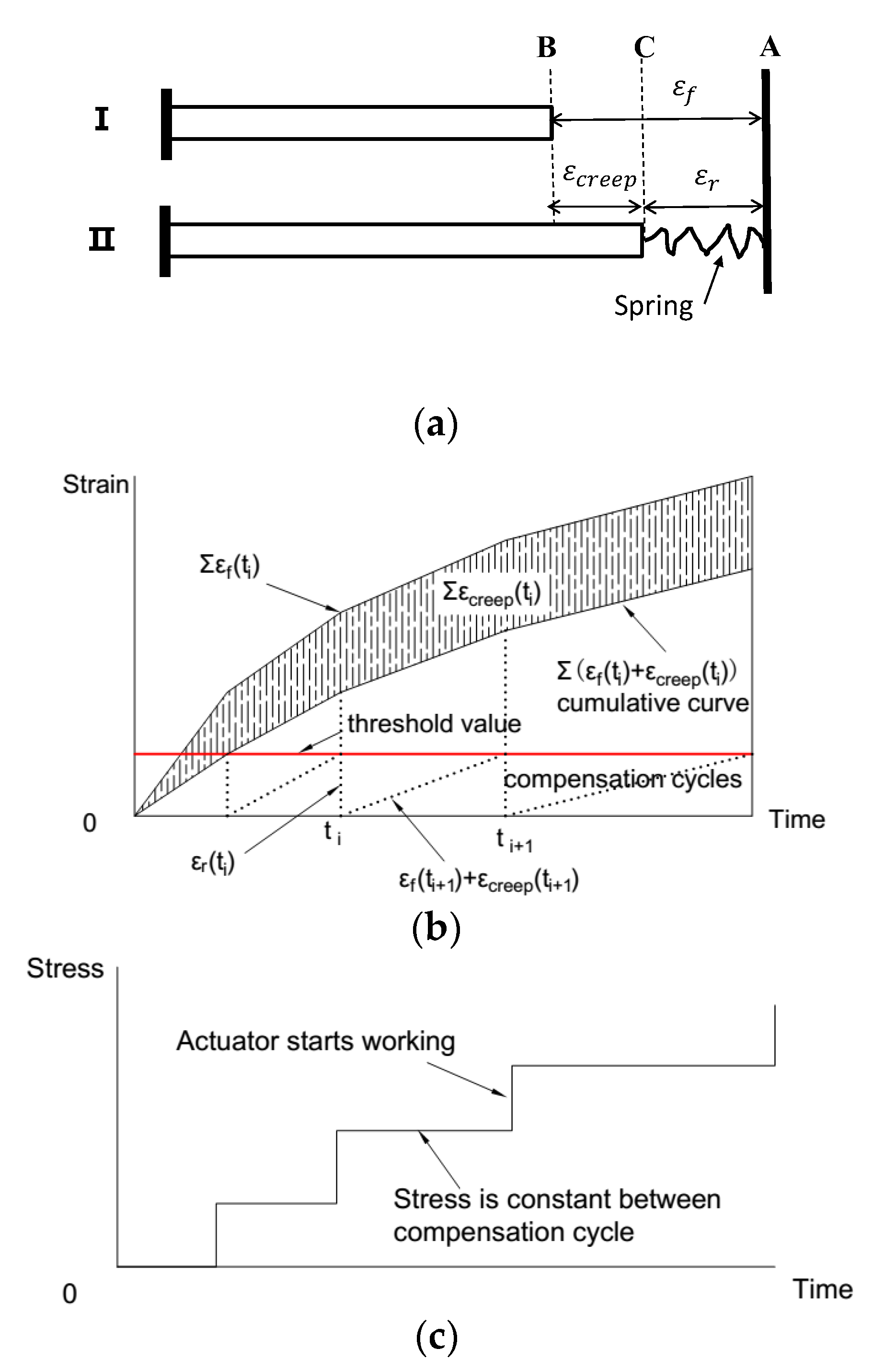
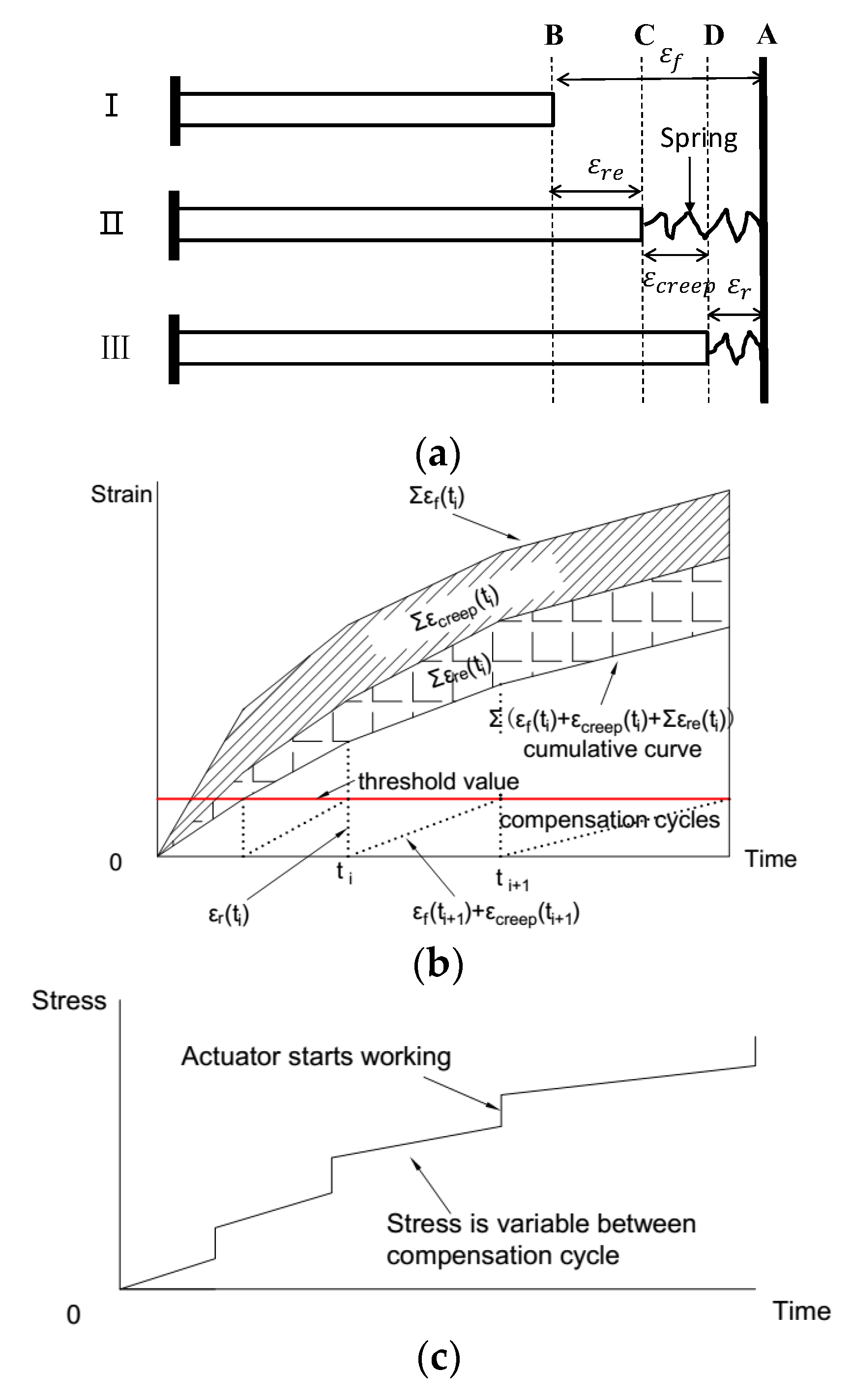
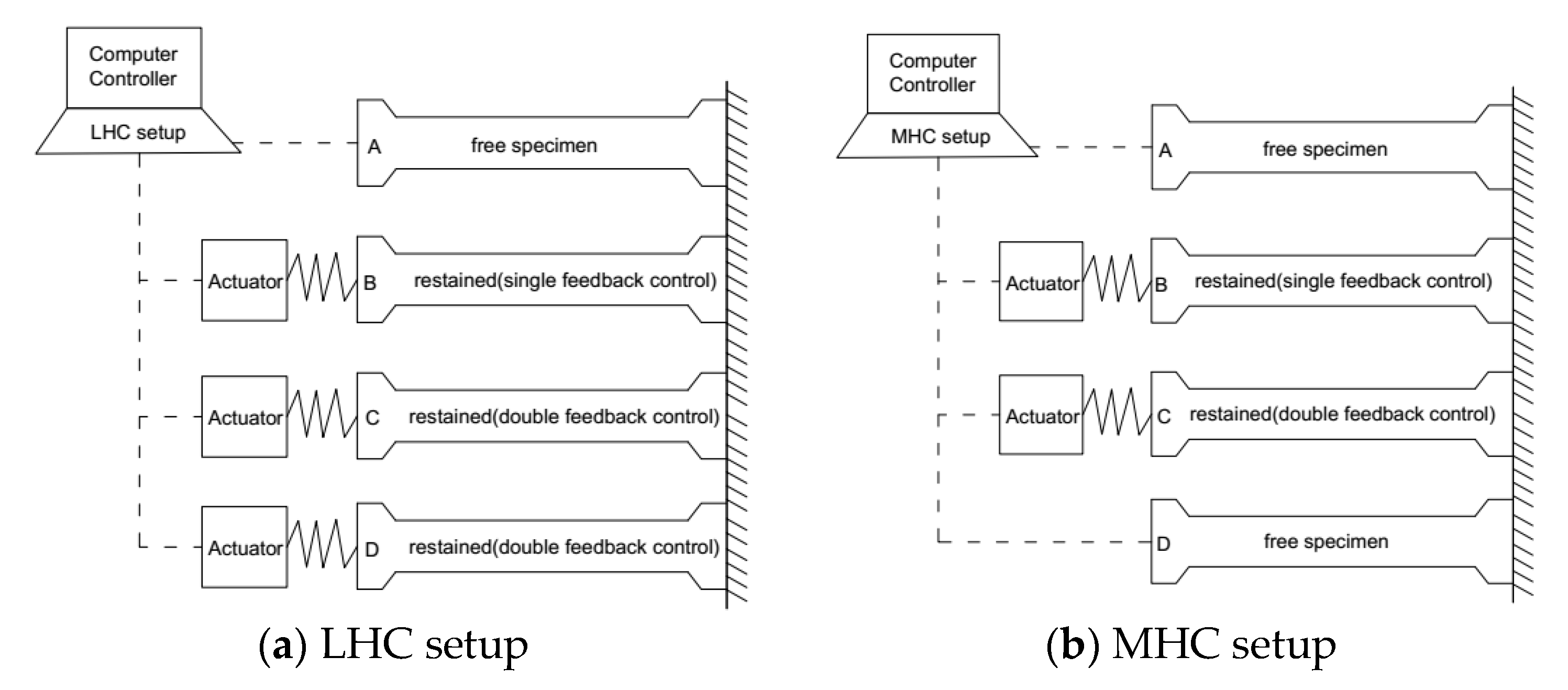
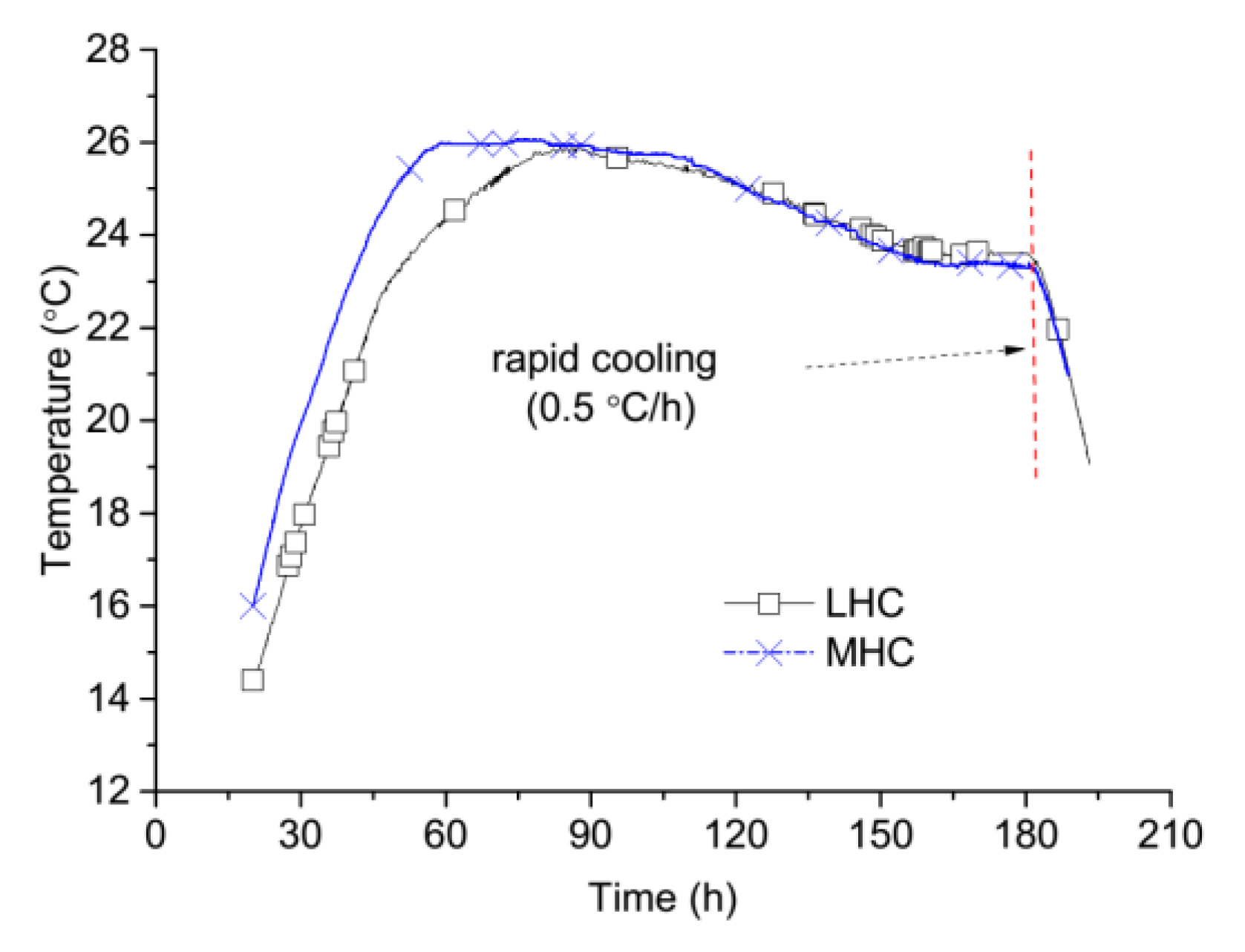
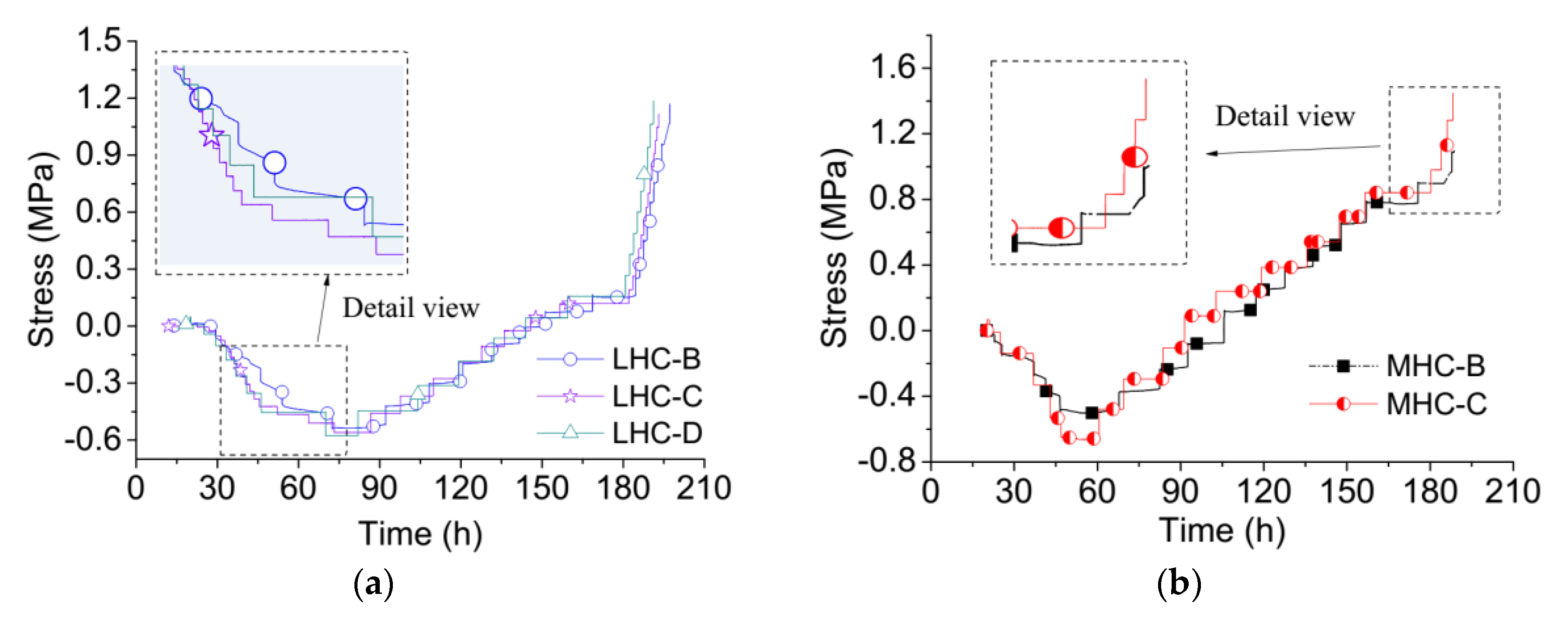
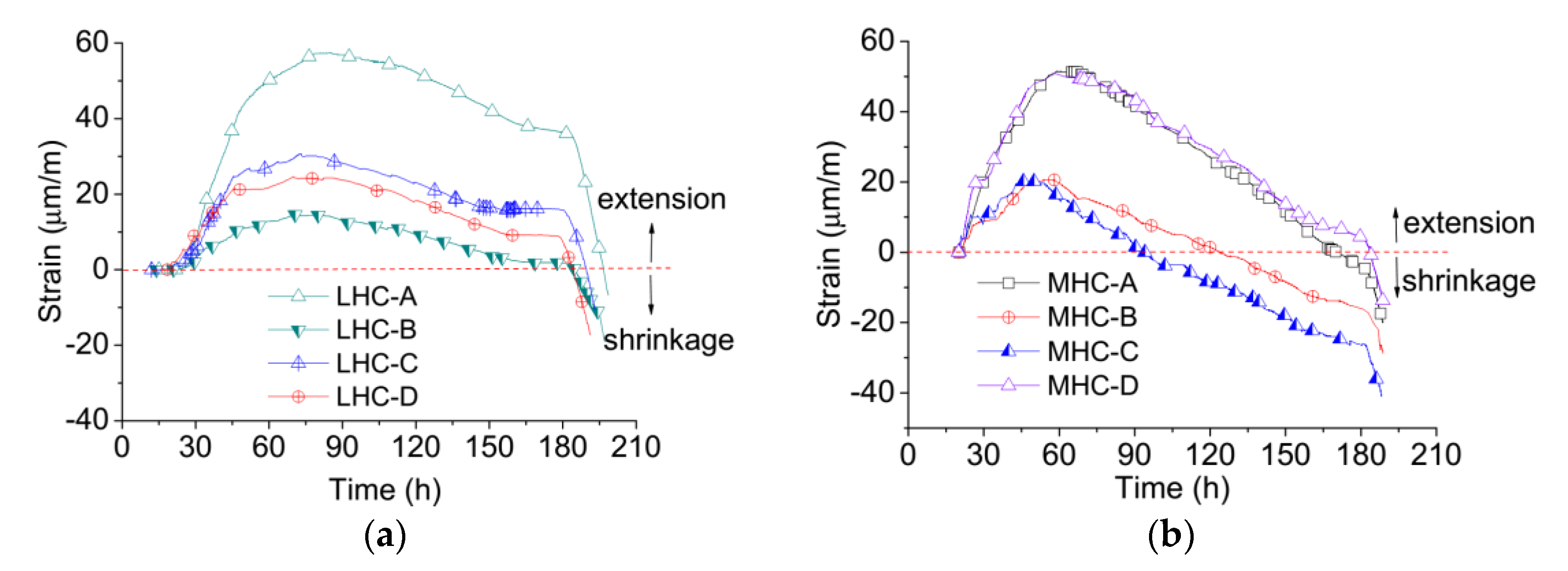

| Water | Cement | Fly Ash | Sand | Gravel | Water-Reducing Admixture | Air-Entraining Admixture |
|---|---|---|---|---|---|---|
| 130.00 | 169.00 | 91.00 | 727.58 | 1351.23 | 1.12 | 0.074 |
| Admixture | Mix Ratio (%) | Water Reduction Ratio (%) | Air Content (%) | Bleeding Rate (%) | Difference in Setting Time (min) | |
|---|---|---|---|---|---|---|
| Initial Setting | Final Setting | |||||
| Water reducing admixture | 0.60 | 19.5 | 1.9 | 25 | +260 | +350 |
| Air entraining admixture | 0.008 | 6.5 | 5.0 | 35 | +40 | +70 |
| Material | CaO | SiO2 | Al2O3 | Fe2O3 | MgO | SO3 | R2O |
|---|---|---|---|---|---|---|---|
| Low heat cement | 58.7 | 22.8 | 4.3 | 4.3 | 4.2 | 3.0 | 0.3 |
| Moderate heat cement | 47.9 | 25.1 | 11.3 | 2.4 | 5.5 | 3.0 | 1.3 |
| Fly ash | 3.2 | 52.4 | 24.0 | 9.4 | 1.1 | 0.4 | 0.9 |
| Concrete | 1 Day | 3 Days | 5 Days | 7 Days | |
|---|---|---|---|---|---|
| LHC | Average value | 10.57 | 14.27 | 16.83 | 21.73 |
| Measured values | 11.60, 11.70, 8.40 | 12.20, 14.40, 16.20 | 15.30, 16.70, 18.00 | 19.00, 22.50, 22.00 | |
| MHC | Average value | 13.90 | 23.27 | 24.27 | 26.67 |
| Measured values | 13.70, 13.80, 14.20 | 23.70, 23.00, 23.10 | 24.10, 23.50, 25.22 | 24.90, 29.50, 25.60 | |
© 2018 by the authors. Licensee MDPI, Basel, Switzerland. This article is an open access article distributed under the terms and conditions of the Creative Commons Attribution (CC BY) license (http://creativecommons.org/licenses/by/4.0/).
Share and Cite
Zhu, H.; Li, Q.; Hu, Y.; Ma, R. Double Feedback Control Method for Determining Early-Age Restrained Creep of Concrete Using a Temperature Stress Testing Machine. Materials 2018, 11, 1079. https://doi.org/10.3390/ma11071079
Zhu H, Li Q, Hu Y, Ma R. Double Feedback Control Method for Determining Early-Age Restrained Creep of Concrete Using a Temperature Stress Testing Machine. Materials. 2018; 11(7):1079. https://doi.org/10.3390/ma11071079
Chicago/Turabian StyleZhu, He, Qingbin Li, Yu Hu, and Rui Ma. 2018. "Double Feedback Control Method for Determining Early-Age Restrained Creep of Concrete Using a Temperature Stress Testing Machine" Materials 11, no. 7: 1079. https://doi.org/10.3390/ma11071079
APA StyleZhu, H., Li, Q., Hu, Y., & Ma, R. (2018). Double Feedback Control Method for Determining Early-Age Restrained Creep of Concrete Using a Temperature Stress Testing Machine. Materials, 11(7), 1079. https://doi.org/10.3390/ma11071079




